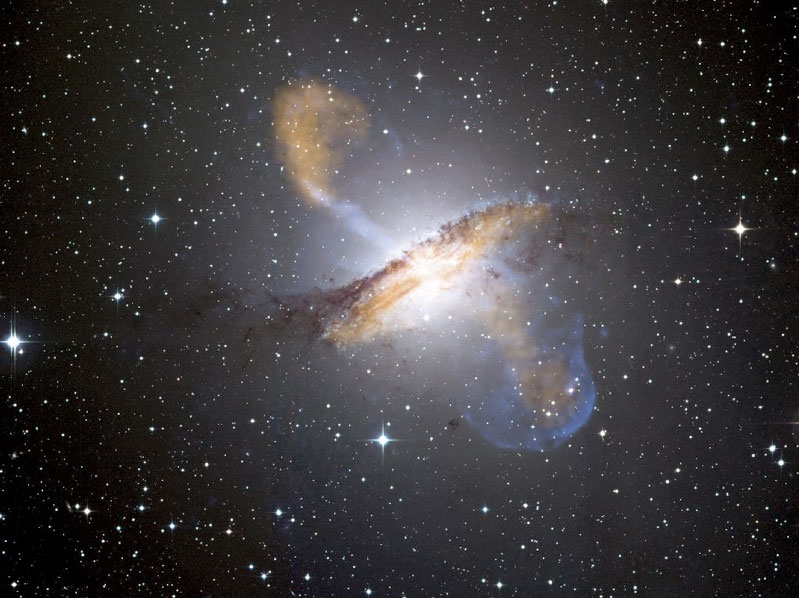Pulsar Wind Nebulae
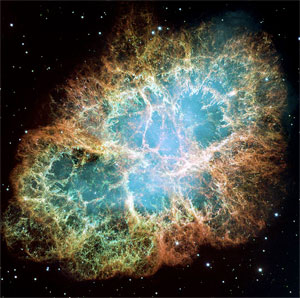
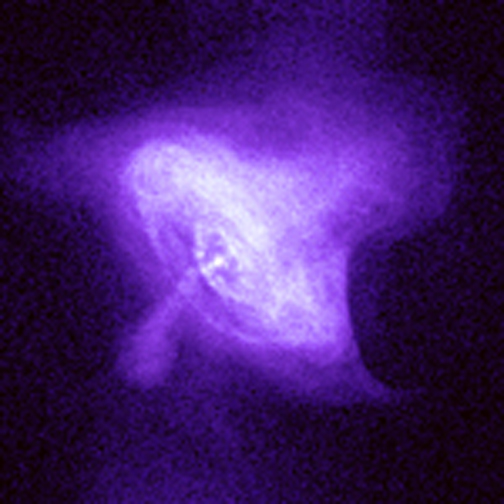 Rotation powered pulsars lose most of their energy to the production
of a relativistic magnetized wind mostly made of electrons and
positrons. PWNe are bubbles of relativistic plasma that arise from
the confinement of such a wind by the surrounding medium (either the
remnant of the parent supernova or the ISM). These sources generally
show a broad non-thermal emission spectrum, shining from radio to
γ-ray frequencies. The emission is interpreted as mostly due
to synchrotron and Inverse Compton radiation from relativistic
particles interacting with the ambient magnetic and photon
field. The highly relativistic outflow emanating from the pulsar
magnetosphere is slowed down at a termination shock where particles
are accelerated with extreme efficiency. A number of properties put
PWNe among the most intriguing and interesting sources in the sky:
they are relativistic sources, likely hosting the most relativistic
outflows in Nature (the pulsar winds, with Lorentz factors possibly
reaching 107-108); they are the most efficient
accelerators in the Galaxy, with efficiencies reaching 20-30%; the
only firmly detected Galactic PeVatrons; and the only well
established reservoirs of leptonic anti-matter in the Galaxy. In
summary, PWNe are sources of chief interest for High Energy
Astrophysics, being the nearest and brightest relativistic sources,
excellent cosmic accelerators and potentially the primary
contributors of cosmic ray positrons, at least above some energy.
Rotation powered pulsars lose most of their energy to the production
of a relativistic magnetized wind mostly made of electrons and
positrons. PWNe are bubbles of relativistic plasma that arise from
the confinement of such a wind by the surrounding medium (either the
remnant of the parent supernova or the ISM). These sources generally
show a broad non-thermal emission spectrum, shining from radio to
γ-ray frequencies. The emission is interpreted as mostly due
to synchrotron and Inverse Compton radiation from relativistic
particles interacting with the ambient magnetic and photon
field. The highly relativistic outflow emanating from the pulsar
magnetosphere is slowed down at a termination shock where particles
are accelerated with extreme efficiency. A number of properties put
PWNe among the most intriguing and interesting sources in the sky:
they are relativistic sources, likely hosting the most relativistic
outflows in Nature (the pulsar winds, with Lorentz factors possibly
reaching 107-108); they are the most efficient
accelerators in the Galaxy, with efficiencies reaching 20-30%; the
only firmly detected Galactic PeVatrons; and the only well
established reservoirs of leptonic anti-matter in the Galaxy. In
summary, PWNe are sources of chief interest for High Energy
Astrophysics, being the nearest and brightest relativistic sources,
excellent cosmic accelerators and potentially the primary
contributors of cosmic ray positrons, at least above some energy.
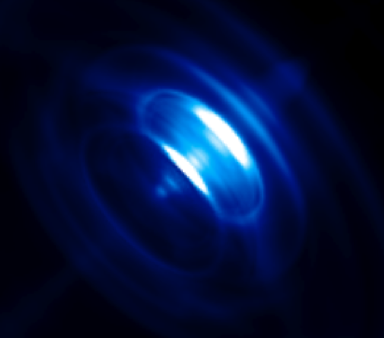 Our group has been deeply involved in the study of PWNe, touching virtually all aspects of their physics. We were one of the first two groups to perform 2D relativistic MHD simulations of a pulsar wind interacting with the surrounding SNR.
These simulations allowed us to show how the anisotropic energy flux of the pulsar wind, higher at the pulsar rotational equator than at the poles, could explain the findings by Chandra, whose high-resolution X-ray observations had just highlighted the existence of an axisymmetric ``jet-torus’’ morphology in the Crab Nebula and then several other young PWNe. The assumed wind structure was that predicted by theoretical modeling of the wind launching by the pulsar magnetosphere, so that our results also provided independent confirmation of the correct description of the pulsar wind energy flow, including vanishing magnetization in the equatorial region.
The overall magnetization of the wind is found instead to be larger
than estimated based on 1D modeling: only sufficiently magnetized
outflows can lead to substantial hoop stresses downstream of the
termination shock so as to divert the post-shock flow towards the axis
and give rise to jets.
Our group has been deeply involved in the study of PWNe, touching virtually all aspects of their physics. We were one of the first two groups to perform 2D relativistic MHD simulations of a pulsar wind interacting with the surrounding SNR.
These simulations allowed us to show how the anisotropic energy flux of the pulsar wind, higher at the pulsar rotational equator than at the poles, could explain the findings by Chandra, whose high-resolution X-ray observations had just highlighted the existence of an axisymmetric ``jet-torus’’ morphology in the Crab Nebula and then several other young PWNe. The assumed wind structure was that predicted by theoretical modeling of the wind launching by the pulsar magnetosphere, so that our results also provided independent confirmation of the correct description of the pulsar wind energy flow, including vanishing magnetization in the equatorial region.
The overall magnetization of the wind is found instead to be larger
than estimated based on 1D modeling: only sufficiently magnetized
outflows can lead to substantial hoop stresses downstream of the
termination shock so as to divert the post-shock flow towards the axis
and give rise to jets.
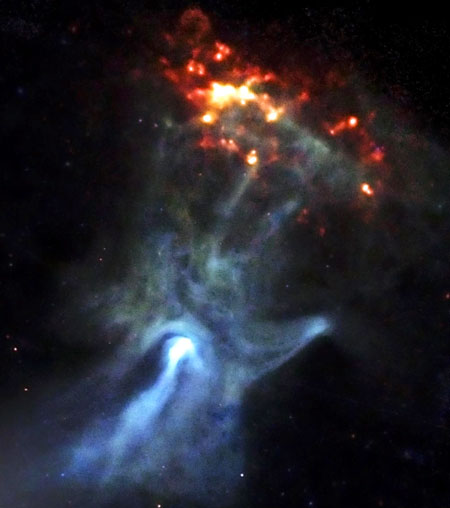 Our further studies including radiation diagnostics opened then the
way to some other puzzles: within axisymmetric MHD simulations, the
morphology and emission spectrum of the Crab Nebula, the class
prototype and one of the astrophysical objects for which data are most
abundant, could not be simultaneously reproduced with a given value of
the wind magnetization. More specifically the magnetization that could
best reproduce the X-ray emission morphology would give origin to a
nebular magnetic field well below the value inferred from
multi-wavelength spectral modeling. A possible solution to this
puzzle, that is currently being investigated, is that the discrepancy
be due to the reduced dimensionality of our simulations. Axisymmetry
suppresses the development of kink instabilities that could instead be
very important in these systems hosting mainly toroidal fields: if
kinks can tangle the field lines without substantial magnetic
dissipation then a larger magnetic field strength can be accommodated
in the nebula without increasing hoop stresses beyond the level that
best fits the morphology. This idea is currently being investigated
with the help of 3-D relativistic MHD simulations, whose preliminary
results are very promising.
Our further studies including radiation diagnostics opened then the
way to some other puzzles: within axisymmetric MHD simulations, the
morphology and emission spectrum of the Crab Nebula, the class
prototype and one of the astrophysical objects for which data are most
abundant, could not be simultaneously reproduced with a given value of
the wind magnetization. More specifically the magnetization that could
best reproduce the X-ray emission morphology would give origin to a
nebular magnetic field well below the value inferred from
multi-wavelength spectral modeling. A possible solution to this
puzzle, that is currently being investigated, is that the discrepancy
be due to the reduced dimensionality of our simulations. Axisymmetry
suppresses the development of kink instabilities that could instead be
very important in these systems hosting mainly toroidal fields: if
kinks can tangle the field lines without substantial magnetic
dissipation then a larger magnetic field strength can be accommodated
in the nebula without increasing hoop stresses beyond the level that
best fits the morphology. This idea is currently being investigated
with the help of 3-D relativistic MHD simulations, whose preliminary
results are very promising.
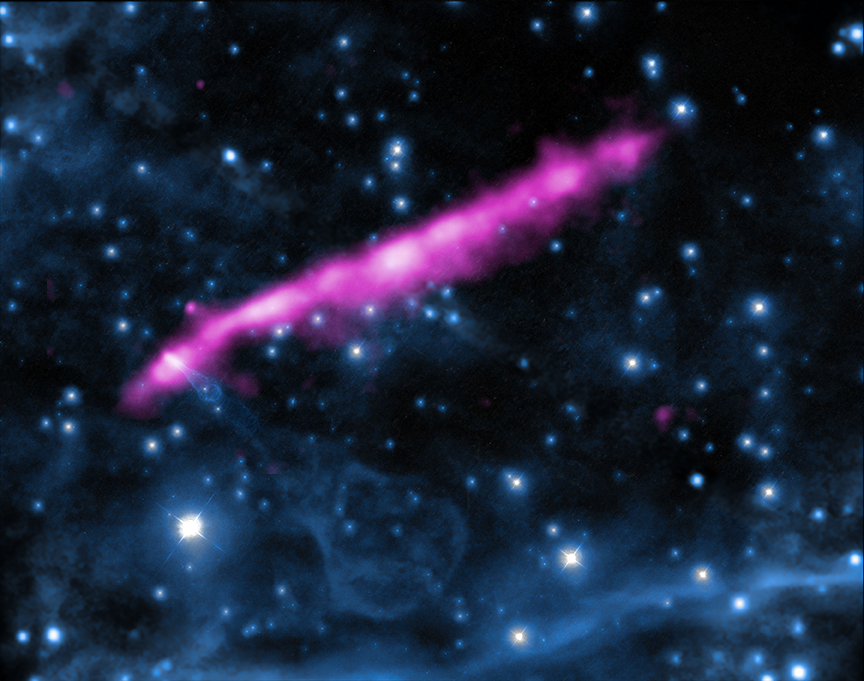 At the same time more refined diagnostics for the evolution of the accelerated particles is being implemented, and a special attention is planned to be devoted, as already in the past, to time-variability in the inner nebula.
Our final purpose is that of using all the information available from
observations to clarify the most fascinating aspects of PWN physics:
the composition, in terms of particles and fields, of the wind that
emanates from the pulsar magnetosphere and what the particle
acceleration mechanism is at the pulsar wind termination shock, a
shock that should not be accelerating particles at all according to
our standard theories and is proven to be instead one of the best
accelerators in the Universe.
Aside from explaining how particles are accelerated in these nebulae,
another increasingly hot topic has to do with their release in the
ISM. The excess of cosmic ray positrons measured by PAMELA and AMS02
has prompted to consider pulsars as possible contributing
sources. Since alternative scenarios either include a radical change
in our view of Cosmic Ray origin or propagation, or interpret the
excess as a signature of Dark Matter related processes, assessing the
pulsar contribution to this excess is particularly topical. Our group
has developed pulsar based models for the origin of the positron
excess that assume that the particles we see are accelerated at PWN
shocks, with the typical flat spectrum that we deduce from
observations of these objects in the radio band, and are only released
in the ISM when the pulsar exits the parent supernova remnant. Pulsars
are a population with high proper velocities and when they leave their
parent SNR often find themselves moving in the ISM with supersonic
speed: this gives rise to the so-called Pulsar Bow Shock Nebulae
observed in radio, X-ray and Hα emission.
Following up on our early work on these objects, we are currently
performing new 2 and 3D relativistic MHD simulations aimed at
clarifying the impact of instabilities and the physics of particle
escape from these systems. Our final goal is that of assessing more
reliably the PWN contribution to the measured leptonic antimatter in
Cosmic Rays and their relevance for the production of high energy
gamma-ray haloes such as those recently observed by HAWC. This is
again very important in view of the advent of CTA.
At the same time more refined diagnostics for the evolution of the accelerated particles is being implemented, and a special attention is planned to be devoted, as already in the past, to time-variability in the inner nebula.
Our final purpose is that of using all the information available from
observations to clarify the most fascinating aspects of PWN physics:
the composition, in terms of particles and fields, of the wind that
emanates from the pulsar magnetosphere and what the particle
acceleration mechanism is at the pulsar wind termination shock, a
shock that should not be accelerating particles at all according to
our standard theories and is proven to be instead one of the best
accelerators in the Universe.
Aside from explaining how particles are accelerated in these nebulae,
another increasingly hot topic has to do with their release in the
ISM. The excess of cosmic ray positrons measured by PAMELA and AMS02
has prompted to consider pulsars as possible contributing
sources. Since alternative scenarios either include a radical change
in our view of Cosmic Ray origin or propagation, or interpret the
excess as a signature of Dark Matter related processes, assessing the
pulsar contribution to this excess is particularly topical. Our group
has developed pulsar based models for the origin of the positron
excess that assume that the particles we see are accelerated at PWN
shocks, with the typical flat spectrum that we deduce from
observations of these objects in the radio band, and are only released
in the ISM when the pulsar exits the parent supernova remnant. Pulsars
are a population with high proper velocities and when they leave their
parent SNR often find themselves moving in the ISM with supersonic
speed: this gives rise to the so-called Pulsar Bow Shock Nebulae
observed in radio, X-ray and Hα emission.
Following up on our early work on these objects, we are currently
performing new 2 and 3D relativistic MHD simulations aimed at
clarifying the impact of instabilities and the physics of particle
escape from these systems. Our final goal is that of assessing more
reliably the PWN contribution to the measured leptonic antimatter in
Cosmic Rays and their relevance for the production of high energy
gamma-ray haloes such as those recently observed by HAWC. This is
again very important in view of the advent of CTA.
 Arcetri High Energy Group
Arcetri High Energy Group 